Zygomatic process
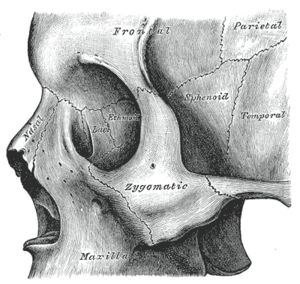
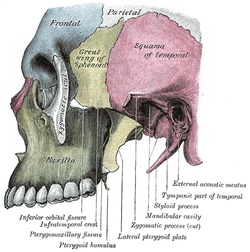
Each Zygomatic process is the part of a bone which articulates with the zygomatic bone. The three processes are:[1]
- Zygomatic process of frontal bone from the frontal bone
- Zygomatic process of maxilla from the maxilla (malar process)
- Zygomatic process of temporal bone from the temporal bone
The term zygomatic derives from the Greek Ζυγόμα zygoma meaning "yoke". The zygomatic process is occasionally referred to as the zygoma, but this term usually refers to the zygomatic bone or occasionally the zygomatic arch.
Zygomatic process of frontal bone
| Zygomatic process of frontal bone | |
|---|---|
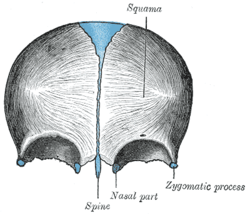 Frontal bone at birth. (Zygomatic process visible at lower right.) | |
| Details | |
| Identifiers | |
| Latin | processus zygomaticus ossis frontalis |
| Anatomical terms of bone | |
The supraorbital margin of the frontal bone ends laterally in its zygomatic process, which is strong and prominent, and articulates with the zygomatic bone. The zygomatic process of the frontal bone extends from the frontal bone laterally and inferiorly.
Zygomatic process of maxilla
The zygomatic process of the maxilla[2] (malar process) is a rough triangular eminence, situated at the angle of separation of the anterior, zygomatic, and orbital surfaces.
- In front it forms part of the anterior surface.
- Behind it is concave, and forms part of the infratemporal fossa.
- Above it is rough and serrated for articulation with the zygomatic bone.
- Below it presents the prominent arched border which marks the division between the anterior and infratemporal surfaces.
Processes of the zygomatic bone
The zygomatic bone itself has four processess, namely the frontosphenoidal, orbital, maxillary and temporal processes.
The frontosphenoidal process is thick and serrated. The cranial suture between the frontal and zygomatic bone is found here. On its orbital surface, just within the orbital margin and about 11 mm below the zygomaticofrontal suture is a tubercle of varying size and form, but present in 95 per cent of skulls (Whitnall 43). This tubercle isn't seen in the picture.
The orbital process is a thick, strong plate, projecting backward and medialward from the orbital margin. It is the gloomy area beneath the lac(rimal) and ethmoidal bones in the image.
The maxillary process presents a rough, triangular surface which articulates with the maxilla. It is the area below "zygomatic" in the image.
The temporal process, long, narrow, and serrated, articulates with the zygomatic process of the temporal. It is the process to the right of "zygomatic" in the image.
Additional images
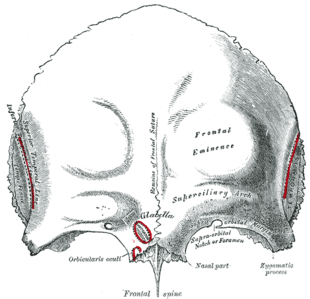 "Frontal bone: Outer surface".
"Frontal bone: Outer surface".- Zygomatic process of frontal bone
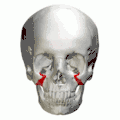 Zygomatic process of maxilla
Zygomatic process of maxilla
References
- ↑ Marieb & Hoehn's (2010) Human Anatomy & Physiology
- ↑ Google Books: zygomatic process of the maxilla: Exercises in Oral Radiology and Interpretation - E-Book (Elsevier Health Sciences, Dec 12, 2003, by Robert P. Langlais)- Retrieved 2018-08-26
This article incorporates text in the public domain from the 20th edition of Gray's Anatomy (1918)
External links
- Photo - look for #6
- "Anatomy diagram: 34256.000-1". Roche Lexicon - illustrated navigator. Elsevier. Archived from the original on 2014-01-01.